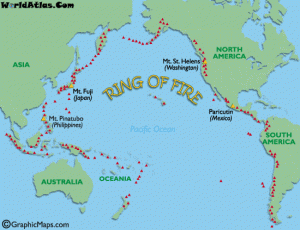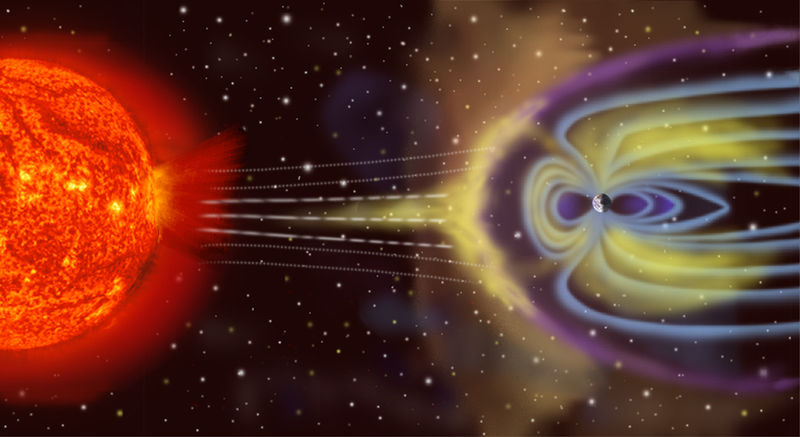Today we are being bathed in a strong solar wind originating from a large coronal hole on the Sun. Just before the solar wind hit Earth within the last couple of days, it struck the planet’s magnetosphere, which in turn may have sparked geomagnetic activity before the actual arrival of the solar wind stream on Earth.
The extraordinary series of seismic events that occurred between 3 and 4 AM GMT on 16 June 2010 may have been touched off by the solar wind impact on the outer reaches of the magnetosphere. The seismically-active “Ring of Fire” bordering the Pacific Ocean was awakened with a start just after 3 AM GMT, striking Indonesia first with a magnitude 7 quake, accompanied by several more strong aftershocks and followed within 45 minutes by two quakes in Alaska of magnitudes 5 and 5.1. Today, a magnitude 4.2 temblor struck not far from Mount Rainier in Washington state – a place that rarely sees earthquakes in the 4+ range.
Based on the timing, it appears that the Alaskan activity may have been triggered by seismic waves travelling along the Earth’s crust, but I’ve yet to determine the time it would take seismic waves to travel there from Indonesia just yet. Of greater interest are the several strong quakes that occurred during that one hour, which may have been related to the approaching solar wind stream.
The correlation between solar activity and earthquakes is noteworthy, and has been reported here before. For instance, a strong solar wind streaming from a coronal hole also impacted the planet’s magnetosphere on about the 12th of January – the same date a devastating quake hit Haiti, causing mass destruction and killing over 200,000 people. And the monster Chilean quake was preceded by just a few days by the collapse of the largest magnetic filament ever observed on the Sun.
Surface damage isn’t the only side effect of tectonic shifting. Unfortunately, the dangers of coal mining may be linked in many cases to gasses released in conjunction with earthquake activity. For instance, the West Virginia mine tragedy in early April of this year was directly preceded by an earthquake centered just under the mine. Earthquakes are a rare event in West Virginia; the correlation between the quake and the subsequent methane explosion cannot be ignored.
Most recently, the deadly Amaga, Colombia coal mine explosion occurred within 24 hours of the Indonesian and Alaska quakes. Although no earthquake was registered in the immediate vicinity of the mine at the time, toxic gasses exploded in a giant fireball just before midnight local time on the 16th, trapping and killing an estimated 72 workers. The accumulation of gas may have been related to slight shifting of the planet’s crust in the northwestern part of Colombia, a seismically-active region in the Ring of Fire.
According to solar physicist David Hathaway of the Marshall Space Flight Center: “When a gust of solar wind hits Earth’s magnetic field, the impact causes the magnetic field to shake (italics mine). If it shakes hard enough, we call it a geomagnetic storm.” Power outages and compass anomalies are associated with strong geomagnetic storms – and auroras, while beautiful to see, are indicators of potentially hazardous ionisation in the atmosphere related to solar wind.
So why isn’t every geomagnetic storm associated with a strong earthquake? One reason may be the release of tectonic pressure associated with relatively-infrequent, large seismic events. For instance, the earthquakes I’ve just been referencing may well have released pressure, essentially preventing large and devastating quakes immediately following the events. That’s not to say that the plates haven’t shifted to the point that another significant seismic or volcanic event could surprise us any day now.
The Indonesian quake of a couple of days ago brings the total of magnitude 7+ earthquakes this year to TEN, and we are not yet even halfway through the year. For reference, I have compiled a list of yearly 7+ quakes yearly going back to the last solar minimum, which was at its lowest in 1996:
1996 15
1997 16
1998 12
1999 18
2000 15
2001 16
2002 13
2003 15
2004 16
2005 11
2006 11
2007 18
2008 12
2009 17
2010 10 (through 16 June)
Clearly, if this rate continues, we’re on track to exceed 20 earthquakes of mag 7+ this year. Worse, we don’t know where the next one will strike; all we have are clues, such as the swarm – the second largest on record – in Yellowstone earlier this year. With seismic activity picking up around the Pacific northwest, home to several active volcanoes and a heavily-populated coastline that could face a deadly tsunami with little to no warning, we would be wise to watch the trends in solar activity and associated geomagnetic affects.
STACE TUSSEL
References:
Also see this new article predicting extreme solar storms and power grid outages, etc., accompanying the upcoming peak of solar maximum in 2013: Telegraph.co.uk

